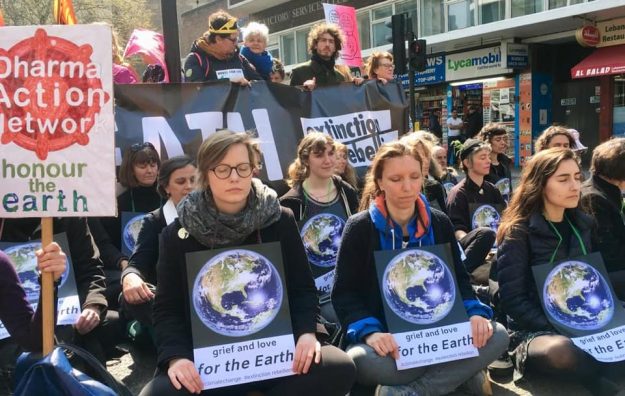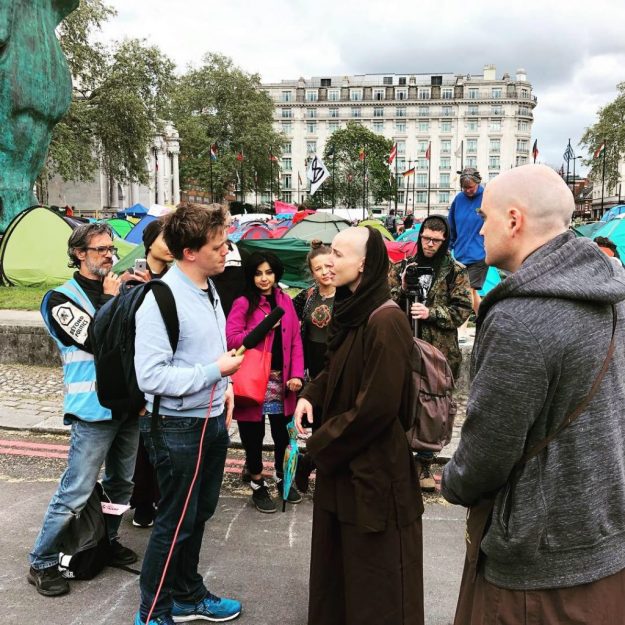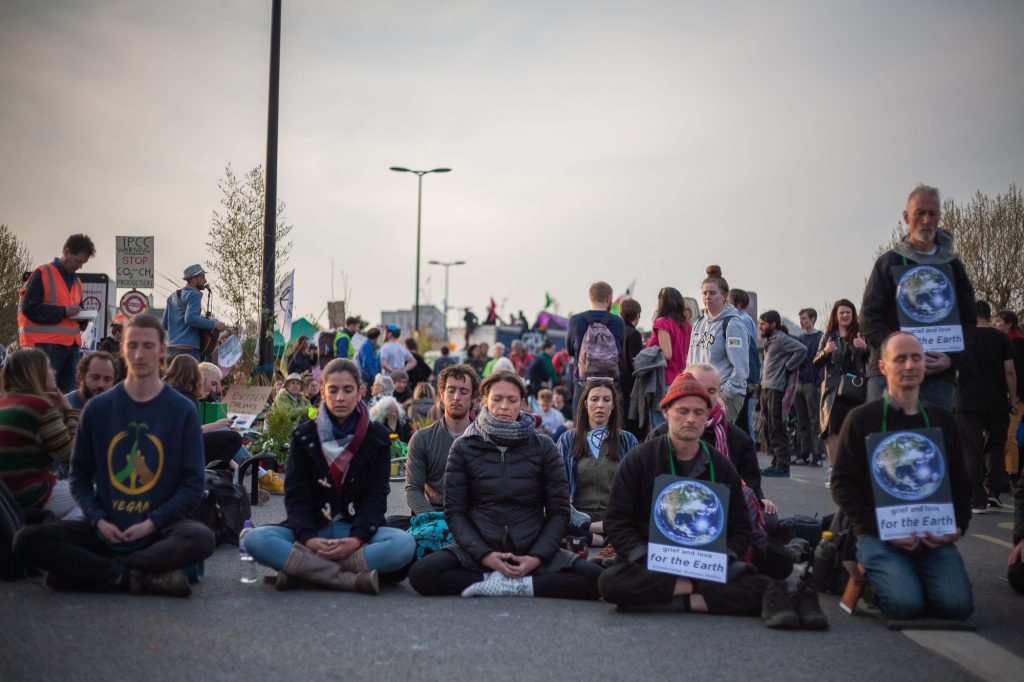The environmental activism group Extinction Rebellion (XR) has been making headlines since November 2018, when around 6,000 protesters blocked traffic on five bridges in London at their first demonstration. They made more waves on April 1, when 12 protestors stripped down to their underwear in the House of Commons and glued their hands down to various surfaces. On April 15, thousands of people took to the streets, shutting down transit stations, streets, and bridges for several days with theatrical displays such as a large pink boat, a halfpipe for skateboarders, and a stage for a choir. By April 19, London police had arrested 682 protesters.
But behind XR’s raucous spectacles is a calm contemplation, according to the many Buddhist teachers and practitioners who have joined the movement. XR organizers have not kept track of their members’ faiths, but religious and spiritual leaders seem to be exceptionally visible at their demonstrations, where it is common to see human blockades engaging in meditation, yoga, or prayer. The group even addresses this perception in an FAQ on their website, writing, “Your movement seems a bit woowoo to me. What’s with the shamans and all that?” Their answer: “Some, though not all of us, have a ‘spiritual’ orientation, and we welcome anyone regardless of their beliefs . . .”
One Buddhist teacher, Mark Ovland, was among the dozen XR activists who were arrested for their “cheeky intervention,” as one British lawmaker described it. Ovland told Tricycle that he has put his teaching on hold and stepped back from his commitments to Buddhist groups to focus on activism. Still, he said, “Extinction Rebellion is just the perfect vehicle for taking practice off the cushion, it has a remarkably dharmic backbone and a lot of how we relate to each other and go about our business would be very familiar to anyone coming from Buddhist circles.”

Ovland is not alone. Robin Boardman, one of the group’s founding members, is a Buddhist practitioner and yoga instructor. XR’s podcast recently featured an interview with Buddhist scholar Joanna Macy, where she talked about the importance of self-care for activists. The closed Facebook group Extinction Rebellion Buddhists has more than 1,250 members. (A similar group for XR Jews had around 250 members, a Quaker group had 700 members, but no other religious group showed up in a search for “Extinction Rebellion” groups.) The New York Insight Meditation Center (NYIMC) has begun hosting climate-related events, and board president Tom Carling has said he hopes that NYIMC can be one of the movement’s “spiritual homes.” Scholar, activist, and Zen teacher David Loy—the author of Ecodharma: Buddhist Teachings for the Ecological Crisis and vice president of the Rocky Mountain Ecodharma Retreat Center in Colorado—was arrested on April 20 at an XR event in Denver, Colorado. And the list goes on.
Related: Awakening in the Age of Climate Change by David Loy
Buddhism in the West is no stranger to activism. Many of today’s most prominent Western dharma teachers came out of the counterculture of the 1960s and 1970s. Activists coined the terms engaged Buddhism and ecodharma to explicitly link their practice and social awareness. But Extinction Rebellion has been more successful at activating engaged Buddhists than other groups with similar goals. What is behind this apparent affinity?
No Violence, No Blame
Many Buddhists see XR as a kindred spirit because of the group’s use of nonviolent civil disobedience and their emphasis on not blaming or shaming people (No. 8 and No. 9 on XR’s list of ten principles and values). The Buddhist activists see those goals as being in line with the teachings of non-harming and compassion.
“What moved me about XR was the sense that we have to respond to everyone from a place of love—to not blame or shame even the apparent beneficiaries or perpetrators of destructive behaviors,” explained Extinction Rebellion activist and dharma teacher Yanai Postelnik. He has been arrested six times at XR demonstrations—including one protest on February 27 when he joined Mark Ovland in super-glueing their hands to the door of a building hosting an oil-industry conference.
Postelnik, who teaches in the Insight meditation tradition, said he originally considered his spirituality and activism to be relatively distinct, but he found himself frequently leaning on his practice at demonstrations.
“If you’re in a position where you’ve committed to your location and you can’t move, being able to relax is really helpful. All those years of sitting with unpleasant sensations turn out to be really helpful when you’re locked to a friend in a position where you’re not going to move,” he said.
“I realized that buddhadharma has a lot to offer here. To be genuinely nonviolent, we need to have a basis in spiritual practice that allows one to deal with the forces that otherwise overwhelm it.”
Related: Climate Change is a Moral Issue by Ven. Bhikkhu Bodhi
Extinction Rebellion is not without its critics. Many have questioned XR’s methods, arguing that their disruptions were hurting working people and alienating possible allies. Others claim the group’s demands are too vague to engender substantial change. But few deny that XR has been effective in bringing attention to the issue of climate change. In May, the UK Parliament conceded to one of Extinction Rebellion’s demands and declared a climate emergency. (Time will tell whether that act was merely meant to appease the protesters or whether it was the first step in a new direction.)
NYIMC’s Tom Carling, who recently took on the role of an action coordinator of XR’s New York chapter, said that he got behind XR because nonviolent civil disobedience is the most effective tool available. “One of the reasons for doing it is that it works. And I think that’s been demonstrated over and over again,” he said.

XR organizers often cite the work of Harvard University professor of human rights and international affairs Erica Chenoweth, who found that over the past century nonviolent resistance has been far more effective overall than violent campaigns, and that successful movements require participation from just 3.5 percent of a population.
Carling expressed concern that the group’s disruptive tactics, while being nonviolent, may not meet the standards of non-harming. But he saw no other way to counteract the destruction of climate change.
“In the end, the objective is to win hearts and minds, to get people to join in the rebellion,” he said. “In order to get the attention of the media and of city officials, we have to create some economic disruption, and certain people are going to be harmed by that. At this point, we feel that is an unfortunate but necessary sacrifice that we’re imposing on other people. But if you put that harm up against the catastrophe that we’re facing, it looks more like tough love. We’re trying to tell the truth about what’s happening, and we’re trying to get people to acknowledge that truth. That’s what these actions are designed for.”
The Death of Death
XR’s principles help explain why Buddhists feel comfortable joining up, but there is a different reason that their cause has resonated with an array spiritually minded people: Climate change is an existential threat, and Extinction Rebellion does not shy away from this harsh reality.
“The very fact that the word extinction is in play is very important,” said Australian Zen teacher and author Roshi Susan Murphy. “If you talk about the extinction of a species, you’re really talking about the death of death. Death ends there—death and all of its propellant force to awakening to life’s creativity. And to bring extinction together with a simple world like rebellion—saying, ‘No, we’re not accepting this’—is very potent.”
Related: Learning to Die in the Anthropocene
The potentially apocalyptic consequences of climate change, Murphy said, raise fundamentally religious and spiritual questions: “There is so obviously a spiritual dimension to the huge existential questions we’re facing,” she said.
Religious News Services reporter Jack Jenkins has written about what he sees as the resurgence of the religious left (or the spiritual left). The Democratic presidential primary race currently includes spiritual teacher Marianne Williamson and mindfulness and yoga practitioner Rep. Tim Ryan as well as the outspokenly religious Sen. Cory Booker and Mayor Pete Buttigieg. None of these candidates are frontrunners, and their effort to court the religious left may turn out to be in vain. Still, the emphasis they place on how spirituality informs their morality suggests that a significant segment of the political left is responding positively to these views.
“It’s hard to get people’s attention without sounding like a religious nut talking about Armageddon coming,” Carling said. “But the truth is that we’re talking about the end of the world, the end of life on the planet. A UN report basically said that if we don’t reduce our carbon output by 40 percent over the next ten years, it will be a catastrophe. People say, ‘We’re doing this for our children.’ But that message leaves out the fact that we’re already in the sixth extinction. We’re already seeing the deadly effects of the climate crisis. It can be overwhelming.”
Regenerative Culture
Climate activism can seem Sisyphean, and the consequences of failure are staggering—the perfect conditions for burnout. XR organizers have created a kind of wellness first-aid kit with a variety of self-care resources, creating another place in the movement where activism and practice intersect, and the Buddhists of XR have noticed.
“In XR, there’s a recognition of the value of different practices for nourishing and regenerating our spirit and our well-being in the context of being engaged in activism or organizing, which can be pretty crazy and chaotic in a decentralized situation,” explained Postelnik. “There’s an understanding that if you just all go at it flat out, you’ll get wiped out. It’s like the XR equivalent of mindfulness.”
The attention to wellbeing is related to one of XR’s principles (#3 on the list): “We need a regenerative culture,” which refers to both sustainable industries and activism. Postelnik explained that these wellness practices found their way into the movement as the more spiritual members shared what they found supportive.

“That’s how the yoga class on the Waterloo Bridge started,” he said. “It’s pretty stressful sitting on a bridge, day and night in the heat, and with the police coming and dragging various members of your community away at times.”
While XR activists have been inspired by a number of traditions, Buddhism has an especially prominent position in the discussions around regenerative culture. On an episode of the Extinction Rebellion podcast, the show’s host, Jessica Townsend, who is a Buddhist, and asked Joanna Macy to share the story of the Shambhala warrior that she learned from Dugu Choegyal Rinpoche:
There comes a time when all life on earth is in danger. At this time, great powers have risen, and they are engaged in programs to abolish each other. And although they waste their wealth and preparations to abolish each other, they have much in common: weapons of unfathomable devastation and death, and technologies that lay waste the world.
And it is in this moment when the future of all beings hangs by the frailest of threads that the kingdom of Shambhala emerges. Now you can’t go there. Because it is not a place. It exists in the hearts and minds of the Shambhala warriors . . . .
Great courage is required of the Shambhala warriors, moral courage and physical courage, because they are . . . going to go where the instruments of death are fabricated and deployed, and they’re going to go into the corridors of power to dismantle these weapons. They know these weapons are mind-made. They are made by the human mind, so they can be unmade by the human mind. Because the devastation is being wrought not by some evil deity, or some extraterrestrial power, but they arise from our lives, our minds, our habits, our relationships, our confusion.
The Path Forward
On October 7, Extinction Rebellion will be kicking off a new wave of international activism. To prepare, organizers have been asking new members to participate in a nonviolent direct action training, which Carling notes teaches the importance of staying aware of one’s own emotions and being grounded in the body.
In New York, Carling is striving to drum up the enthusiasm that is on display in England. He hopes to provide mindfulness classes for climate activists at NYIMC and has plans to increase the center’s programing around climate crisis issues.
Related: Reflections on an Impermanent World, a special section
In Australia, XR is in its early stages, Murphy said. She and other monks and nuns in the Sydney region plan to march in their robes under the banner of “Extinction Rebellion Buddhists” at the School Strike for Climate on September 20. The school strike movement has been gaining steam in Australia where kids are following the lead of teen activist Greta Thunberg, whose work has earned the admiration of His Holiness the 14th Dalai Lama.

While there are many reasons for the overlap of Buddhists and climate activists, which vary from person to person, it’s clear that Extinction Rebellion has stirred something in the engaged Buddhist community.
For Murphy, the simplest explanation is the best one: “It’s dharma to protect the Earth.”
Correction (09/18): An earlier version of this article incorrectly referred to David Loy as the founder of the Rocky Mountain Ecodharma Retreat Center. The center was founded by its executive director and president, Johann Robbins. Loy currently serves as the vice president. We regret the error.
Thank you for subscribing to Tricycle! As a nonprofit, we depend on readers like you to keep Buddhist teachings and practices widely available.
